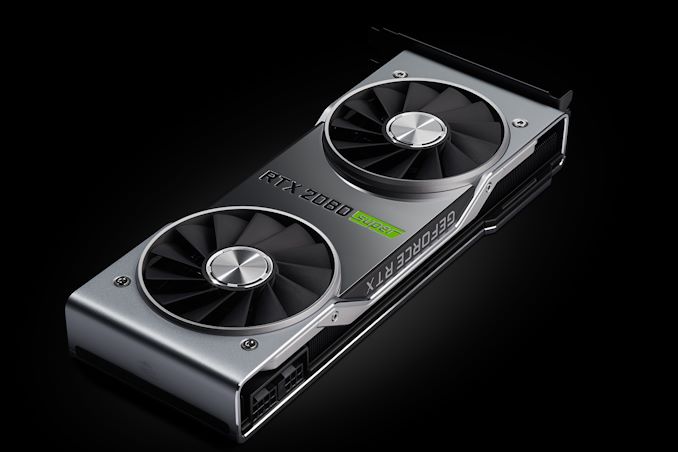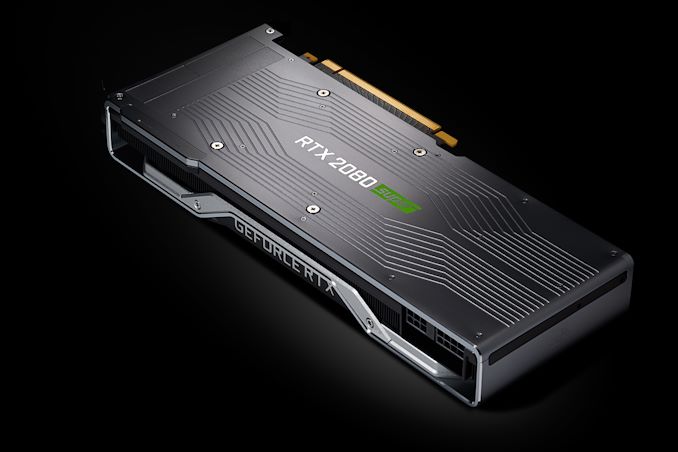The NVIDIA GeForce RTX 2080 Super Review: Memories of the Future
by Ryan Smith on July 23, 2019 9:00 AM EST- Posted in
- GPUs
- GeForce
- NVIDIA
- Turing
- GeForce RTX
Meet the GeForce RTX 2080 Super Founders Edition
Taking a closer look at the RTX 2080 Super, there aren’t too many surprises to be found. Since we’re dealing with a mid-generation kicker here, NVIDIA has opted to stick with their original RTX 2080 reference designs for the new card, rather than design wholly new boards. This has allowed them to get the new card out relatively quickly, and to be honest there’s not a whole lot NVIDIA could do here that wouldn’t be superficial. As a result, the RTX 2080 Super is more or less identical to the RTX 2080 it replaces.
| GeForce RTX 20 Series Card Compariaon | ||||
| RTX 2080 Super Founders Edition |
RTX 2080 Super (Reference Specs) |
|||
| Base Clock | 1650MHz | 1650MHz | ||
| Boost Clock | 1815MHz | 1815MHz | ||
| Memory Clock | 15.5Gbps GDDR6 | 15.5Gbps GDDR6 | ||
| VRAM | 8GB | 8GB | ||
| TDP | 250W | 250W | ||
| Length | 10.5-inches | N/A | ||
| Width | Dual Slot | N/A | ||
| Cooler Type | Open Air (2x Axial Fans) |
N/A | ||
| Price | $699 | $699 | ||
As I noted earlier, the Founders Edition cards themselves are now purely reference cards. NVIDIA isn’t doing factory overclocks this time around – the high reference clock speeds making that process a bit harder – so the RTX 2080 Super Founders Edition is very straightforward examples of what reference-clocked RTX 2080 Super cards can deliver in terms of performance. It also means that the card no longer carries a price premium, with NVIDIA selling it at $699.
Externally then, possibly the only material change is quite literally in the materials. NVIDIA has taken the 2080 reference design and given the center segment of shroud a reflective coating. This, along with the Super branding, are the only two visually distinctive changes from the RTX 2080 reference design. For better or worse, the reflective section is every bit the fingerprint magnet that you probably expect, so thankfully most people aren’t handling their video cards as much as hardware reviewers are.
In terms of cooling, this means the RTX 2080 Super gets the RTX 2080’s cooler as well. At a high level this is a dual axial open air cooler, with NVIDIA sticking to this design after first introducing it last year. The open air cooler helps NVIDIA keep their load noise levels down, though idle noise levels on all of the RTX 20 series reference cards has been mediocre, and the new Super cards are no different. The fact that this reference design isn’t a blower means that the RTX 2080 Super isn’t fully self-exhausting, relying on the computer chassis itself to help move hot air away from the card. For most builders this isn’t an issue, but if you’re building a compact system or a system with limited airflow, you’ll want to make sure your system can handle the heat from a 250W video card.
Under the hood, the RTX 2080 Super inherits the RTX 2080’s heatsink design, with a large aluminum heatsink running the full length of the card. Deeper still, the heatsink is connected to the TU104 GPU with a vapor chamber, to help move heat away from the GPU more efficiently. Overall, the amount of heat that needs to be moved has increased, thanks to the higher TDP, however as this is also the same cooler design that NVIDIA uses on the 250W RTX 2080 Ti, it's more than up to the task for a 250W RTX 2080 Super.
According to NVIDIA the PCB is the same as on the regular RTX 2080. As I need this card for further testing, I haven’t shucked it down to its PCB to take inventory of components. But as the RTX 2080 was already a "fully populated" PCB as far as VRM circuitry goes, the same will definitely be true for the RTX 2080 Super as well. I have to assume NVIDIA is just driving their VRMs a bit harder, which shouldn't be an issue given what their cooler can do. It is noteworty though that as a result, the card's maximum power target is just +12%, or 280W. So while the card has a good bit of TDP headroom at stock, there isn't much more that can be added to it. Factoring in pass-through power for the VirtualLink port, and NVIDIA is right at the limit of what they can do over the 8pin + 6pin + slot power delivery configuration.
Finally, for display I/O, the card gets the continuing NVIDIA high-end standard of 3x DisplayPort 1.4, 1x HDMI 2.0b, and 1x VirtualLink port (DP video + USB data + 30W USB power).














111 Comments
View All Comments
Cellar Door - Tuesday, July 23, 2019 - link
The delta compression used by Nvidia is loseless.notashill - Tuesday, July 23, 2019 - link
If memory bandwidth was "the" bottleneck then the Radeon VII would be the fastest consumer level GPU on the market by an enormous margin.Samus - Tuesday, July 23, 2019 - link
Sadly I think you are right. While commendable AMD has always pushed higher memory capacities to the mainstream, their focus on memory bandwidth has never really paid off, and at a huge expense to die area for the larger memory controller, and obviously an energy efficiency deficit. This is why 3-channel memory was dropped in favor of reversion back to two channel with the Intel X58 chipset. It would be years before we would move beyond two channel again, and even then - quad channel never became mainstream.The reason is simple. Even on single channel, Intel CPU’s especially show extraordinary memory performance. The controller is well optimized and cache hit rates are high. Likewise, Nvidia using excellent compression with optimized caches makes high memory bandwidth unnecessary.
willis936 - Tuesday, July 23, 2019 - link
SISD benefits greatly from caching and ILP. SIMD doesn’t need to run ILP to keep execution units busy so it chews through memory bandwidth by comparison. There is also quick diminishing returns on GPU cache size. GPUs have 20x the memory bandwidth of CPUs for a good reason: they use it.flyingpants265 - Monday, July 29, 2019 - link
Somewhat related to the subject of compression... adaptive resolution is by far the best graphics technology I have ever seen. Render at 1800p, drop down to 1400p when below the target framerate, and upscale everything to 4k. No need to buy the highest-end graphics card anymore. If we had adaptive resolution when Far Cry 1 came out, there would have been no market for the 6800, just use a 6600.Combine with checkerboarding for console, which is impressive in its own right by NEAR-HALVING the workload. So render at half 1800p every other frame (equivalent of about 2300*1300 pixels, so 1.44x 1080p, not 4.0x) and get a generated 4k image.
notashill - Tuesday, July 23, 2019 - link
Radeon VII has double the bandwidth for the same price but it doesn't really help performance at least in games. I think there has been more focus on effectively utilizing bandwidth because making the buses wider can get really expensive.Smell This - Tuesday, July 23, 2019 - link
Hard to say . . .GDDR6 has a good deal of *theoretical* bandwidth on the table, there is the economical 'ghetto-HBM2' from Sammy, and HBM3 in the short-term.
We are likely to hear about Radeon **Navi-Instinct** pro cards this quarter, in addition to a Titan/Ampere 7nm HPC update. I'm thinking the trend will continue toward more efficient 'wider' bandwidth and advances in compression algorhtms, too.
wr3zzz - Tuesday, July 23, 2019 - link
How are these new cards draw so much more power than GTX980 under load yet have lower load temperature and noise? Are the new fans that good?Ryan Smith - Tuesday, July 23, 2019 - link
Blower versus open air (axial) cooler.Betonmischer - Tuesday, July 23, 2019 - link
Absolutely, if you compare against the reference blower that Nvidia used prior to RTX 20.